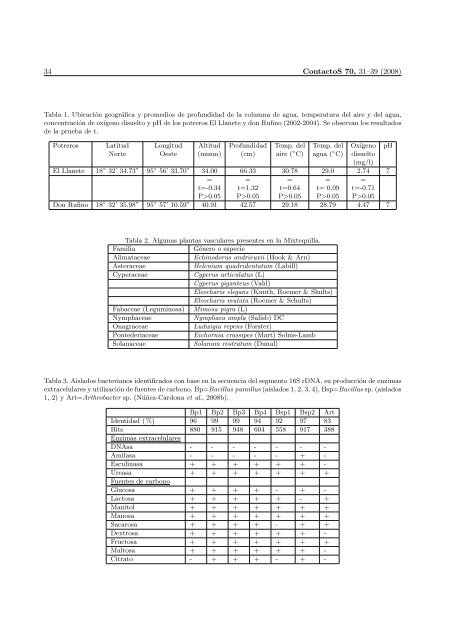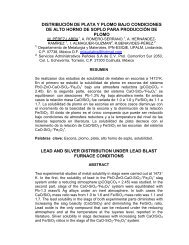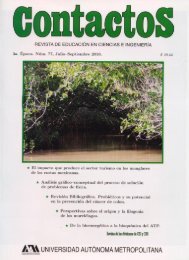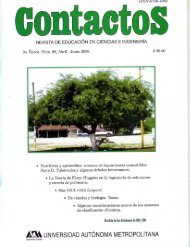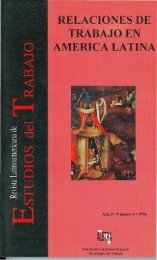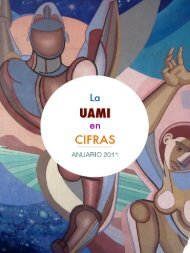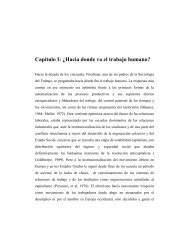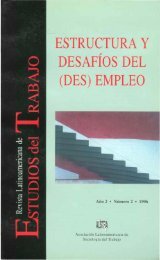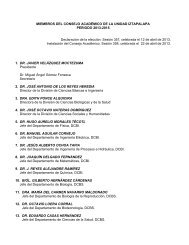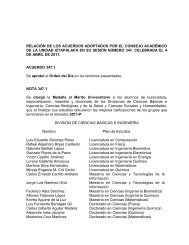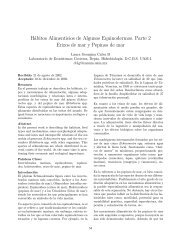Algunos aspectos ambientales y biológicos de dos potreros ...
Algunos aspectos ambientales y biológicos de dos potreros ...
Algunos aspectos ambientales y biológicos de dos potreros ...
You also want an ePaper? Increase the reach of your titles
YUMPU automatically turns print PDFs into web optimized ePapers that Google loves.
34 ContactoS 70, 31–39 (2008)<br />
Tabla 1. Ubicación geográfica y promedios <strong>de</strong> profundidad <strong>de</strong> la columna <strong>de</strong> agua, temperatura <strong>de</strong>l aire y <strong>de</strong>l agua,<br />
concentración <strong>de</strong> oxígeno disuelto y pH <strong>de</strong> los <strong>potreros</strong> El Llanete y don Rufino (2002-2004). Se observan los resulta<strong>dos</strong><br />
<strong>de</strong> la prueba <strong>de</strong> t.<br />
Potreros Latitud Longitud Altitud Profundidad Temp. <strong>de</strong>l Temp. <strong>de</strong>l Oxígeno pH<br />
Norte Oeste (msnm) (cm) aire ( ◦ C) agua ( ◦ C) disuelto<br />
(mg/l)<br />
El Llanete 18 ◦ 32’ 34.73” 95 ◦ 56’ 33.70” 34.00 66.33 30.78 29.0 2.74 7<br />
= = = = =<br />
t=-0.34 t=1.32 t=0.64 t= 0.09 t=-0.71<br />
P>0.05 P>0.05 P>0.05 P>0.05 P>0.05<br />
Don Rufino 18 ◦ 32’ 35.98” 95 ◦ 57’ 10.59” 40.91 42.57 29.18 28.79 4.47 7<br />
Tabla 2. Algunas plantas vasculares presentes en la Mixtequilla.<br />
Familia<br />
Género o especie<br />
Alimataceae Echinodorus andrieuxii (Hook & Arn)<br />
Asteraceae Helenium quadri<strong>de</strong>ntatum (Labill)<br />
Cyperaceae Cyperus articulatus (L)<br />
Cyperus giganteus (Vahl)<br />
Eleocharis elegans (Kunth, Roemer & Shults)<br />
Eleocharis mutata (Roemer & Schults)<br />
Fabaceae (Leguminosa) Mimosa pigra (L)<br />
Nymphaceae Nymphaea ampla (Salisb) DC<br />
Onagraceae Ludwigia repens (Forster)<br />
Ponte<strong>de</strong>riaceae Eichornia crassipes (Mart) Solms-Lamb<br />
Solanaceae Solanum rostratum (Dunal)<br />
Tabla 3. Aisla<strong>dos</strong> bacterianos i<strong>de</strong>ntifica<strong>dos</strong> con base en la secuencia <strong>de</strong>l segmento 16S rDNA, su producción <strong>de</strong> enzimas<br />
extracelulares y utilización <strong>de</strong> fuentes <strong>de</strong> carbono. Bp=Bacillus pumillus (aisla<strong>dos</strong> 1, 2, 3, 4), Bsp=Bacillus sp. (aisla<strong>dos</strong><br />
1, 2) y Art=Arthrobacter sp. (Núñez-Cardona et al., 2008b).<br />
Bp1 Bp2 Bp3 Bp4 Bsp1 Bsp2 Art<br />
I<strong>de</strong>ntidad ( %) 96 99 99 94 92 97 83<br />
Bits 880 915 948 604 558 917 388<br />
Enzimas extracelulares<br />
DNAsa - - - - - - -<br />
Amilasa - - - - - + -<br />
Esculinasa + + + + + + -<br />
Ureasa + + + + + + +<br />
Fuentes <strong>de</strong> carbono<br />
Glucosa + + + + - + -<br />
Lactosa + + + + + - +<br />
Manitol + + + + + + +<br />
Manosa + + + + + + +<br />
Sacarosa + + + + - + +<br />
Dextrosa + + + + + + -<br />
Fructosa + + + + + + +<br />
Maltosa + + + + + + -<br />
Citrato - + + + - + -


